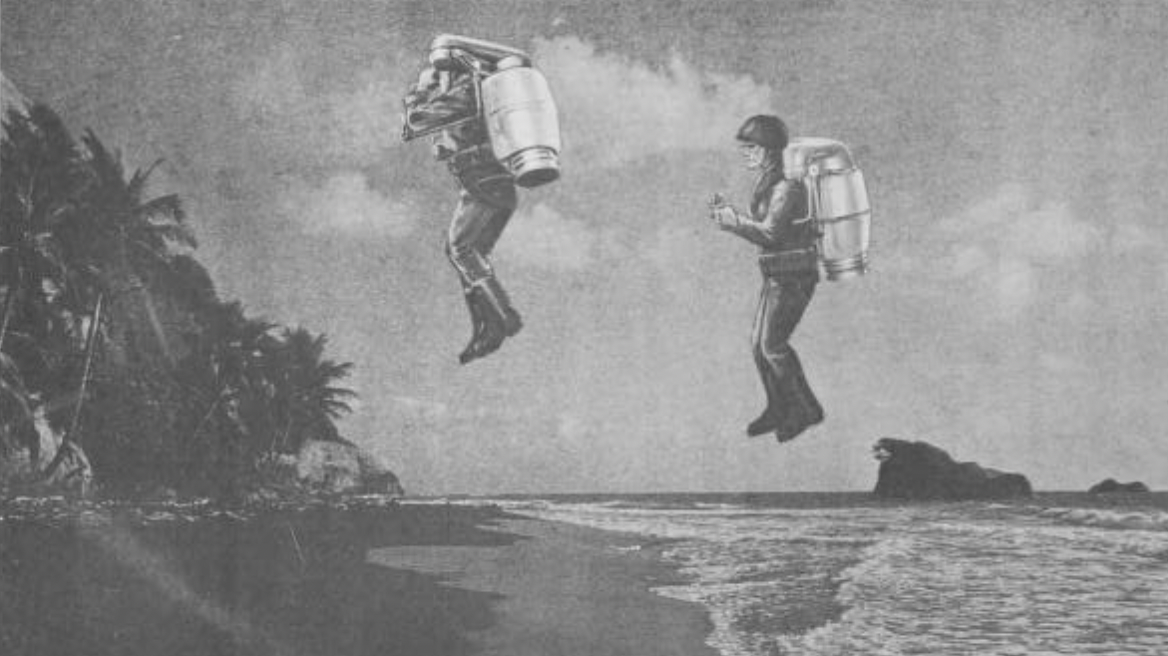

The Army was promised jetpacks. At least briefly. From the end of World War II to well into the 1950s, U.S. Army experiments kept pushing the idea of giving soldiers limited flight, as a way to make infantry more mobile and more effective on the battlefield.
The idea of a jetpack — a human-sized portable rocket pack meant to propel the wearer off the ground for short or prolonged flight — dated back to the 1910s when a Russian inventor proposed it. The idea stuck around and in the late 1950s the U.S. Army began commissioning proposals and studies into developing it for soldiers. A March 1961 U.S. Army Transportation Research Command (TRECOM) report laid out the idea of a jetpack as an “answer to a generalized requirement for increased mobility of the foot soldier.”
It would work “wherein small rocket units are attached directly to an individual to provide him a short flight capability. An analytical study of the feasibility of such a system has revealed that such a device can be built with characteristics of reliability, stability, and controllability, and one which would be safe for operation by relatively inex-perienced personnel.”
This wasn’t out of the blue. The Army has had an interest in going “up” throughout the 20th Century. Before the formation of NASA to concentrate and organize various space-related endeavors, the U.S. Army was experimenting with and testing different ways for soldiers or weapons to elevate. That included everything from sending balloonists up to the stratosphere to building the Redstone ballistic missiles. The jet packs were just one of the smaller projects — financially and literally — in development. In the aftermath of World War II, the U.S. military and defense contractors were diving into rocketry, rapidly developing and testing new propulsion systems for ships, aircraft and even missiles.
It was such a serious part of the Army’s research and development that the “soldier of the future” debuted in 1959 with a jetpack. It was meant to assist in bounding towards enemy trenches or fortifications rather than turning an infantry soldier into a flying ace. The Army envisioned soldiers being able to leap 30 feet thanks to a “jump belt.” Much like the Moon base, that vision did not pan out, particularly in the short timeframe that the Army imagined.
Despite that, the Army and contractors tried several projects. The Aerojet-General Corporation conducted a study in 1960 but one of the most in-depth attempts was the Bell “Small Rocket Lift Device,” also known as the Rocket Belt. Engineer Wendell Moore had been working on it since the early 1950s but work ramped up in the 1960s, including a test demonstration in front of President John F. Kennedy in 1961. The design had some issues. Outside of limited range and lift, fuel storage and consumption were concerns for the military.
Despite that, Bell pursued its jetpack idea throughout the 1960s. With the escalation of the Vietnam War, the company put forth a new version, the “Light Mobility System.” Mockups in a proposal show troops using a backpack-like design to fly over the waters and jungles of a tropical environment, able to move distances in a short time.
“This system is capable of operating over a greater distance in less time than is possible with the ground reconnaissance patrol,” the 1967 document said. “It would provide a more responsive means of determining and verifying intelligence which cannot be obtained as rapidly by higher-level resources. Included are missions such as providing point and flank security for moving elements.”
Notably the Bell report mentions that specific armaments for these jetpack riding soldiers would need to be considered, or else recoil could drastically impact flight operations. The images themselves though mostly show troops with their hands occupied guiding the jetpack.
Despite the positive sell from Bell on the versatility of such a jetpack in warfare, it did not get as much of a push, and troops in Vietnam were not doing rocket jumps. By the late 1960s, military strategy and weapons development had shifted to other focuses. The military never fully gave up on jetpacks as a potential tool, but it was never pursued with the same urgency.
The latest on Task & Purpose
- Special Forces soldier dies in non-combat incident at Eglin range
- A Marine’s disciplinary record from 100 years ago reveals rank-and-file life as much the same
- Navy shoots down its own F/A-18 in Red Sea fight
- The Coast Guard is building up its Arctic fleet
- Coast Guard pilot receives top flying honor for helicopter rescue
